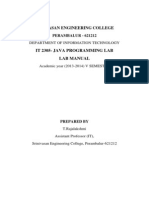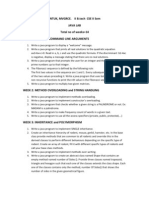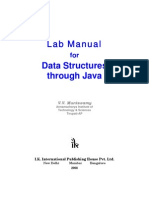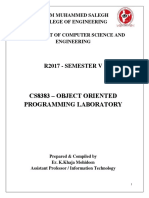Java Programming Lab
Uploaded by
Vasantha KumarJava Programming Lab
Uploaded by
Vasantha KumarIT2305
JAVA PROGRAMMING LAB
L T PC 0032
1. Develop a Java package with simple Stack and Queue classes. Use JavaDoc comments for documentation. 2. Design a class for Complex numbers in Java. In addition to methods for basic operations on complex numbers, provide a method to return the number of active objects created. 3. Design a Date class similar to the one provided in the java.util package. 4. Develop with suitable hierarchy, classes for Point, Shape, Rectangle, Square, Circle, Ellipse, Triangle, Polygon, etc. Design a simple test application to demonstrate dynamic polymorphism. 5. Design a Java interface for ADT Stack. Develop two different classes that implement this interface, one using array and the other using linked-list. Provide necessary exception handling in both the implementations. 6. Write a Java program to read a file that contains DNA sequences of arbitrary length one per line (note that each DNA sequence is just a String). Your program should sort the sequences in descending order with respect to the number of 'TATA' subsequences present. Finally write the sequences in sorted order into another file. 7. Develop a simple paint-like program that can draw basic graphical primitives in different dimensions and colors. Use appropriate menu and buttons. 8. Develop a scientific calculator using even-driven programming paradigm of Java. 9. Develop a template for linked-list class along with its methods in Java. 10. Design a thread-safe implementation of Queue class. Write a multi-threaded producer-consumer application that uses this Queue class. 11. Write a multi-threaded Java program to print all numbers below 100,000 that are both prime and fibonacci number (some examples are 2, 3, 5, 13, etc.). Design a thread that generates prime numbers below 100,000 and writes them into a pipe. Design another thread that generates fibonacci numbers and writes them to another pipe. The main thread should read both the pipes to identify numbers common to both. 12. Develop a multi-threaded GUI application of your choice. TOTAL:45 PERIODS Requirement for a batch of 30 students S. No. Description of Equipment Quantity Required Quantity available Deficiency %
3.
Hardware: Pentium IV with 2 GB RAM, 160 GB HARD Disk, Monitor 1024 x 768 colour 60 Hz. Software: Windows /Linux operating system JDK 1.6(or above)
30 Nodes
4.
30 user license
48
You might also like
- It2305 Java Programming Lab L T P C 0 0 3 2 List of ExperimentsNo ratings yetIt2305 Java Programming Lab L T P C 0 0 3 2 List of Experiments1 page
- Jawaharlal Nehru Technological University Anantapur: (9A05402) Object Oriented ProgrammingNo ratings yetJawaharlal Nehru Technological University Anantapur: (9A05402) Object Oriented Programming5 pages
- Object Oriented Programming Using Java Lab Manual (4+2)No ratings yetObject Oriented Programming Using Java Lab Manual (4+2)3 pages
- BCA-103: Computer Basics and PC Software: Periods/week: 3L, 1T Max. Marks: 100No ratings yetBCA-103: Computer Basics and PC Software: Periods/week: 3L, 1T Max. Marks: 10012 pages
- CS8383 Object Oriented Programming Laboratory LTPC 0 0 4 2 ObjectivesNo ratings yetCS8383 Object Oriented Programming Laboratory LTPC 0 0 4 2 Objectives2 pages
- BS-210 Core Java Programming Lab Manual: C T Group of Institutions JalandharNo ratings yetBS-210 Core Java Programming Lab Manual: C T Group of Institutions Jalandhar48 pages
- CS1303 Object Oriented Programming LaboratoryNo ratings yetCS1303 Object Oriented Programming Laboratory3 pages
- Full Stack Development Lab Report (ITL761)No ratings yetFull Stack Development Lab Report (ITL761)59 pages
- BIT 282 Java Programming Lab: Course ObjectivesNo ratings yetBIT 282 Java Programming Lab: Course Objectives1 page
- Lab Manual Course Code: CS2131 Semester-III: Object Oriented Programming LabNo ratings yetLab Manual Course Code: CS2131 Semester-III: Object Oriented Programming Lab11 pages
- IT4L2 Java Lab Credits:2 Internal Assessment: 25 Marks Lab: 3 Periods/week Semester End Examination: 50 Marks ObjectivesNo ratings yetIT4L2 Java Lab Credits:2 Internal Assessment: 25 Marks Lab: 3 Periods/week Semester End Examination: 50 Marks Objectives2 pages
- EC 2257 Electronics Circuits Ii and Simulation Lab 0 0 3 2No ratings yetEC 2257 Electronics Circuits Ii and Simulation Lab 0 0 3 21 page
































































